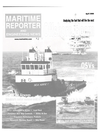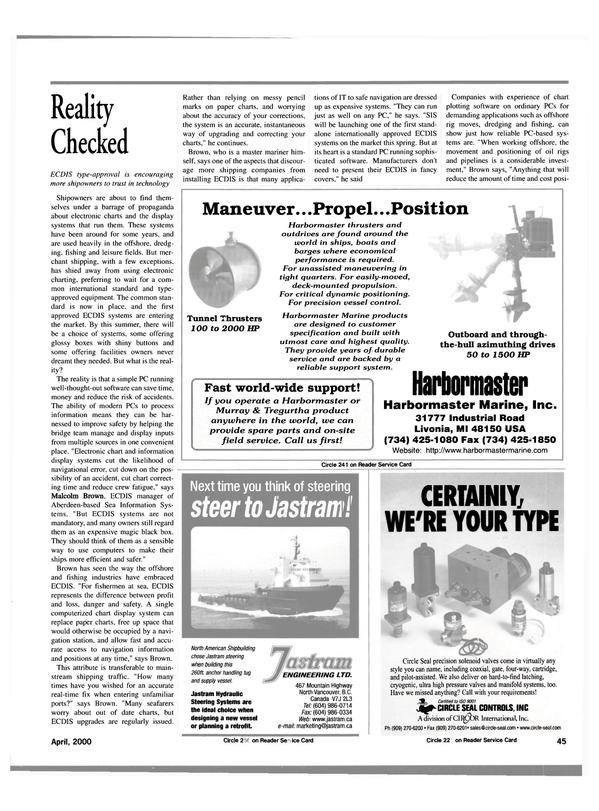
Reality Checked
ECDIS type-approval is encouraging more shipowners to trust in technology Shipowners are about to find themselves under a barrage of propaganda about electronic charts and the display systems that run them. These systems have been around for some years, and are used heavily in the offshore, dredging, fishing and leisure fields. But merchant shipping, with a few exceptions, has shied away from using electronic charting, preferring to wait for a common international standard and typeapproved equipment. The common standard is now in place, and the first approved ECDIS systems are entering the market. By this summer, there will be a choice of systems, some offering glossy boxes with shiny buttons and some offering facilities owners never dreamt they needed. But what is the reality?
The reality is that a simple PC running well-thought-out software can save time, money and reduce the risk of accidents.
The ability of modern PCs to process information means they can be harnessed to improve safety by helping the bridge team manage and display inputs from multiple sources in one convenient place. "Electronic chart and information display systems cut the likelihood of navigational error, cut down on the possibility of an accident, cut chart correcting time and reduce crew fatigue," says Malcolm Brown, ECDIS manager of Aberdeen-based Sea Information Systems.
"But ECDIS systems are not mandatory, and many owners still regard them as an expensive magic black box.
They should think of them as a sensible way to use computers to make their ships more efficient and safer." Brown has seen the way the offshore and fishing industries have embraced ECDIS. "For fishermen at sea, ECDIS represents the difference between profit and loss, danger and safety. A single computerized chart display system can replace paper charts, free up space that would otherwise be occupied by a navigation station, and allow fast and accurate access to navigation information and positions at any time," says Brown.
This attribute is transferable to mainstream shipping traffic. "How many times have you wished for an accurate real-time fix when entering unfamiliar ports?" says Brown. "Many seafarers worry about out of date charts, but ECDIS upgrades are regularly issued.
Rather than relying on messy pencil marks on paper charts, and worrying about the accuracy of your corrections, the system is an accurate, instantaneous way of upgrading and correcting your charts," he continues.
Brown, who is a master mariner himself, says one of the aspects that discourage more shipping companies from installing ECDIS is that many applications of IT to safe navigation are dressed up as expensive systems. "They can run just as well on any PC," he says. "SIS will be launching one of the first standalone internationally approved ECDIS systems on the market this spring. But at its heart is a standard PC running sophisticated software. Manufacturers don't need to present their ECDIS in fancy covers," he said Companies with experience of chart plotting software on ordinary PCs for demanding applications such as offshore rig moves, dredging and fishing, can show just how reliable PC-based systems are. "When working offshore, the movement and positioning of oil rigs and pipelines is a considerable investment," Brown says, "Anything that will reduce the amount of time and cost posi- tioning a platform in its correct location, will be attractive to the owners of the rig." ECDIS is ideal for this. It avoids costly delays as hydrographers confirm and re-confirm that the platform is over the right spot. "By plugging ECDIS software into a GPS plotter, the exact location is easier to pinpoint," he says.
SIS markets a range of software under its Microplot label. Each combines on a single screen all the necessary navigational and environmental information required for the bridge team to make quick and safe assessments of impeding situations. Microplot software was designed by master mariners for mariners, and has a track record stretching back to 1984 in the offshore, fishing and dredging industries. In general shipping, Canada Maritime and a number of other leading operators have chosen to fit Microplot systems in a bid to improve safety.
"This success in general shipping has been a result of listening to what ship operators want. Some owners may be put off by the idea of fitting another expensive black box when it is not yet a requirement of the rules," says Brown.
"But if they see it as a straightforward PC system which adds to safety, saves time and is cost effective, they can begin to use IT for other uses. It is the software that is the key, not the shiny buttons on the cabinets."
Read Reality Checked in Pdf, Flash or Html5 edition of April 2000 Maritime Reporter
Other stories from April 2000 issue
Content
- Corsaire 13000 Embodies Integrated, Advanced Propulsion System page: 48D
- Jotun: Greening the trade in crude page: 8
- Financing Sources for U.S. Government Programs page: 14
- Deltamarin And Almaco Join Together page: 18
- ASRY Reports Prosperous 1999 page: 18
- A New View page: 20
- The Smokeless Solution Is Coming Over The Horizon page: 22
- Strategic Value Adding Purchasing page: 28
- DCR Optimistic About Future Of Offshore Drilling Sector page: 34
- Offshore Industry Leaders Invest Heavily In Safety Programs page: 36
- Electronic Engines Power New OSV Breed page: 40
- Angola And Canada Provide Projects For Smit Pioneer page: 40
- Rig Repowered At Houston Ship Repair page: 41
- Charting The World Electronically page: 44
- Reality Checked page: 45
- NoFire Technologies Helps Ships Meet SOLAS page: 48
- Is Diesel-Electric Propulsion the System for You? page: 50
- Drew Marine, MAN B&W Launch Redesigned Fuel Mill page: 52
- Austal Breaks 24-Hour Record page: 53
- PropExpert V. 4.2 Released page: 53
- GE To Supply Gas Turbines For IHI page: 54
- Jabsco Offers Oil Change Kit page: 54
- Calling All Mariners page: 56
- MTN, BT Hook-Up Cruise Ships To Cell Phone Network page: 59
- Norwegian Manufacturers Maintain Edge page: 60
- Leica Extends Its Influence In DGPS Arena page: 69
- ViaSat Ups Phase Two page: 69
- Encouraging best practice onboard using video and interactive media page: 73
- Blount Completes Dinner Vessel page: 74
- ACCL Offers New Chicago-Based Cruises page: 78
- Boatracs To Exclusively Distribute MarStar page: 78
- DNV Cleans Up With Celebrity's Millennium page: 79
- Transas Unveils GMDSS Simulator page: 85


